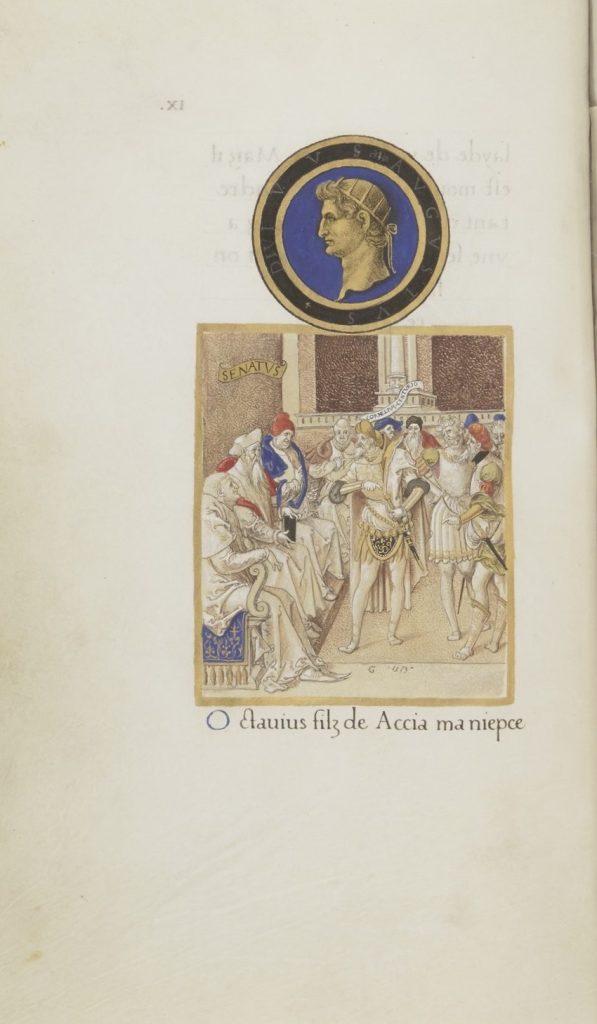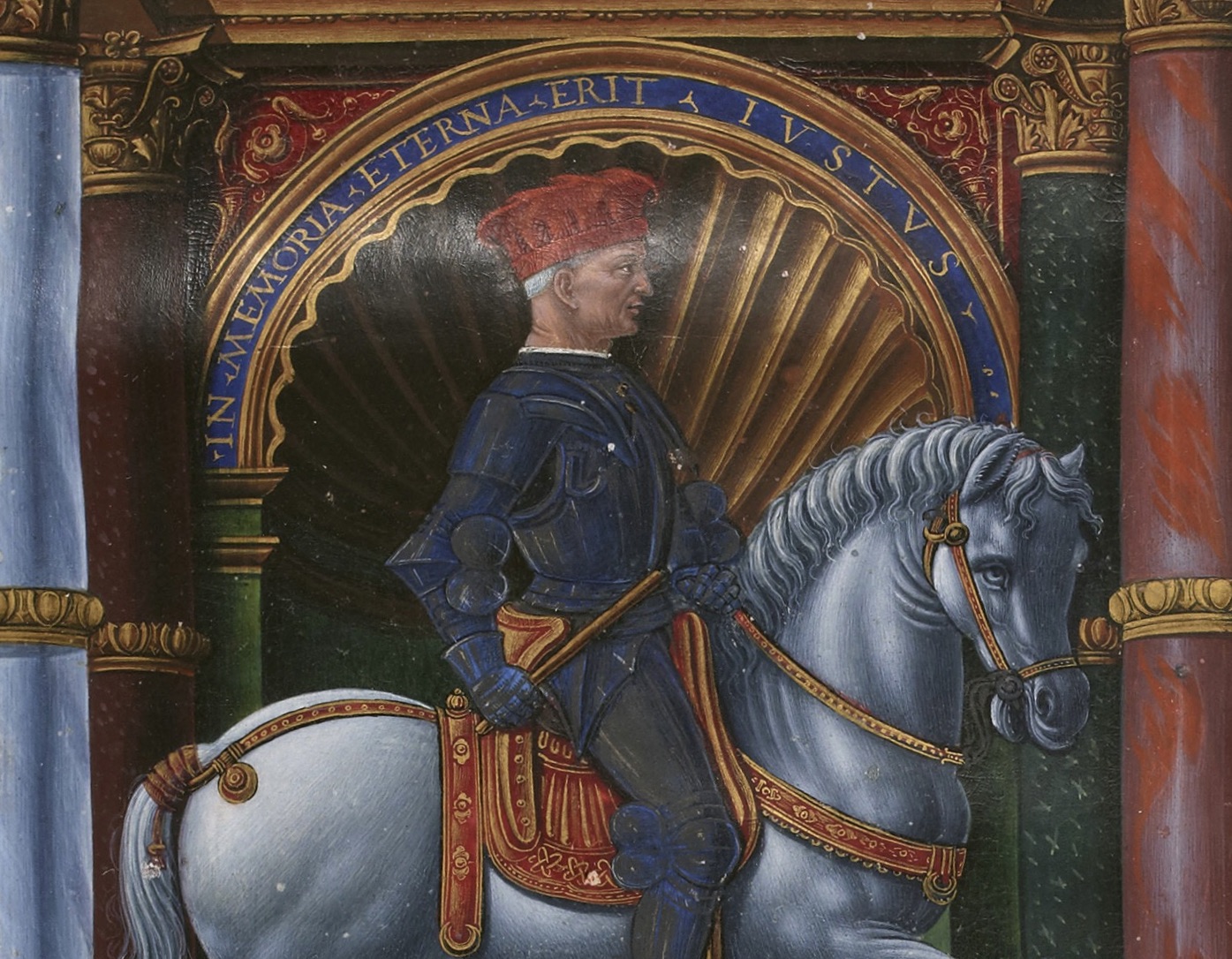L’humaniste, le prince et l’artiste
De uitvinding van de Renaissance . De humanist, de prins en de kunstenaar.
Expositie in de Bibliothèque Nationale in Parijs
20 februari – 16 juni 2024

In: Antonio Minuti, Leven van Muzio Attendolo Sforza .BnF, département des manuscrits
Van de 14e tot de 16e eeuw was Europa het toneel van een nieuw intellectueel, artistiek en wetenschappelijk elan, dat later de Renaissance werd genoemd. Het humanisme stond centraal: geboren in het Italië van de 14e eeuw en gekenmerkt door een terugkeer naar oude teksten en het herstel van de beschavingswaarden uit de Oudheid. Juist in deze tijd werden er door vorsten prachtige bibliotheken aangelegd die hun prestige en zelfbewustzijn moesten onderstrepen.
Het is in de Nationale Bibliotheek van Parijs (Site:Richelieu) dat er aan deze periode aandacht wordt besteed. Een grote expositie genoemd: “L’invention de la Renaissance L’humanisme, le prince et l’artiste wordt er gehouden van 20 februari tot 16 juni 2024.

De presentatie van meer dan 200 werken, waaronder manuscripten, gedrukte boeken, prenten, tekeningen, schilderijen, beeldhouwwerken en kunstvoorwerpen, munten en medailles uit de collecties van BnF en externe bruiklenen uit grote Parijse collecties (Musée du Louvre, Musée Jacquemart-André) dompelt de bezoeker onder in de wereld van het denken van de humanisten uit de Renaissance.

Aan het einde van de Middeleeuwen werd in Italië een nieuw cultuurmodel uitgevonden, dat zich al snel over het hele schiereiland verspreidde voordat het zich in de 16e eeuw over de rest van Europa verspreidde. Later bekend als het humanisme, was het gebaseerd op een ongekende inspanning om het literaire, intellectuele en artistieke erfgoed van de Oudheid samen te brengen. Met hetzelfde enthousiasme werd actief gezocht naar de oudste manuscripten van teksten van klassieke auteurs, werden archeologische overblijfselen opgegraven en verzameld en werden literaire en artistieke vormen geïmiteerd die door dit prestigieuze verleden waren nagelaten. De bibliotheek kreeg een nieuwe glans door het humanisme, zij werd zowel een plaats om te leren als een bron van inspiratie.

Het humanisme was echter geen puur wetenschappelijke studie die zich beperkte tot het overdenken van een voorbije tijd. Een nieuwe visie op de mens kwam voort uit een herontdekte vertrouwdheid met de werken uit de heidense oudheid en ook de bewondering voor haar helden. De Renaissance mens was optimistisch gestemd en zag de mens als een schepsel met potentie. Hij vierde zijn waardigheid en vrijheid en erkende eveneens zijn vermogen om te scheppen en zijn vermogen om te handelen. Deze opkomst van het zelfbewustzijn van de mens was een ontwikkeling die Europa diep heeft beïnvloed.

Source: BnF MSS Latin 8016
Zelf vind ik deze periode altijd heel interessant omdat ze een periode van transitie is. Boeken veranderen in hun visuele vormgeving van onder andere de bladspiegel en een toenemend realisme in de voorstellingen. Je zou kunnen zeggen dat er een nieuw decoratief vocabulaire werd ontwikkeld in de handschriften. ( Architecturale versieringen in de stijl van de Oudheid, medaillon-motieven gekopieerd van antieke munten etc.) Het toewenden van de mens naar de wereld leverde vele prachtig, nog steeds verluchte manuscripten op. Virtuositeit op enkele centimeters die het nieuwe levensgevoel tonen. Maar ook het gedrukte boek komt op en vertoont nog enige tijd gelijkenis met eerdere manuscripten. Soms worden de initialen nog met de hand aangebracht en worden er voorstellingen geschilderd. Zelfs perkament werd nog even gekoesterd als superieur materiaal, zelfs bij gedrukte boeken.

Opvallend is de verandering van het schrift en bladspiegel. De pagina’s doen soms bijna kaal aan. Verder is het schrift met de humanistische minuskel en cursief heel fris aandoend en van een grote schoonheid. In de pagina’s met afbeeldingen zien we vaak een complete omlijsting van de tekst met randen vol van antieke decoraties. (Zie hieronder).




Voor wie dit voorjaar naar Parijs gaat of er langs komt lijkt me deze tentoonstelling een aanrader. De exposities in de BNF zijn altijd van een zekere grandeur is mijn ervaring. Wat ook opvallend is dat er altijd voldoende ruimte is om op je gemak de werken te bekijken. Kortom: aanbevolen.
Voor verdere informatie:
https://www.bnf.fr/fr/agenda/linvention-de-la-renaissance
Voor wie wel is geïnteresseerd maar geen kans ziet om de tentoonstelling te bezoeken is er altijd nog de mogelijkheid van de catalogus. Verkrijgbaar vanaf 15 februari.

L’invention de la Renaissance – L’humaniste, le prince et l’artiste Gebonden
door: Gennaro Toscano (Auteur) € 45,-
The invention of the Renaissance
The invention of the Renaissance . The humanist, the prince and the artist.
Exhibition at the Bibliothèque Nationale in Paris
From the 14th to 16th centuries, Europe was the scene of a new intellectual, artistic and scientific élan, later called the Renaissance. Humanism was central: born in 14th-century Italy and characterised by a return to ancient texts and the restoration of the civilising values of antiquity. It was precisely during this time that monarchs built magnificent libraries to underline their prestige and self-confidence.
It is at the National Library of Paris (Site:Richelieu) that attention is paid to this period. A major exhibition called: “L’invention de la Renaissance L’humanisme, le prince et l’artiste will be held there from 20 February to 16 June 2024

The presentation of more than 200 works, including manuscripts, printed books, prints, drawings, paintings, sculptures and artefacts, coins and medals from BnF’s collections and external loans from major Parisian collections (Musée du Louvre, Musée Jacquemart-André) immerses visitors in the world of Renaissance humanists’ thinking.
At the end of the Middle Ages, a new model of culture was invented in Italy, which soon spread throughout the peninsula before spreading to the rest of Europe in the 16th century. Later known as humanism, it was based on an unprecedented effort to bring together the literary, intellectual and artistic heritage of antiquity. With the same enthusiasm, it actively sought the oldest manuscripts of texts by classical authors, excavated and collected archaeological remains and imitated literary and artistic forms bequeathed by this prestigious past. The library took on a new luster through humanism; it became both a place of learning and a source of inspiration.
However, humanism was not a purely scientific study limited to contemplating a bygone era. A new vision of man emerged from a rediscovered familiarity with the works of pagan antiquity and also admiration for its heroes. Renaissance man was optimistic and saw man as a creature with potential. He celebrated his dignity and freedom and also recognised his ability to create and his capacity to act. This rise of man’s self-awareness was a development that deeply influenced Europe.

Personally, I always find this period very interesting because it is a period of transition. Books change in their visual design of, among other things, the page layout and an increasing realism in the representations. You could say that a new decorative vocabulary was developed in manuscripts. ( Architectural decorations in the style of antiquity, medallion motifs copied from ancient coins, etc.) Man’s turning towards the world produced many beautifully, still-illuminated manuscripts. Virtuosity on a few centimetres showing the new sense of life. But the printed book also emerges and for some time still bears resemblance to earlier manuscripts. Sometimes initials are still applied by hand and representations are painted. Even parchment was still cherished as a superior material for a while, even in the case of printed books.

The change in writing and page layout is striking. The pages sometimes appear almost bare. Otherwise, the writing with the humanist minuskel and italics is very fresh and of great beauty. In the pictorial pages, we often see a complete framing of the text with borders full of antique decorations.
For those going to or passing through Paris this spring, I think this exhibition is highly recommended. The exhibitions at the BNF are always of a certain grandeur is my experience. What is also striking is that there is always enough space to view the works at your leisure. In short: recommended!
